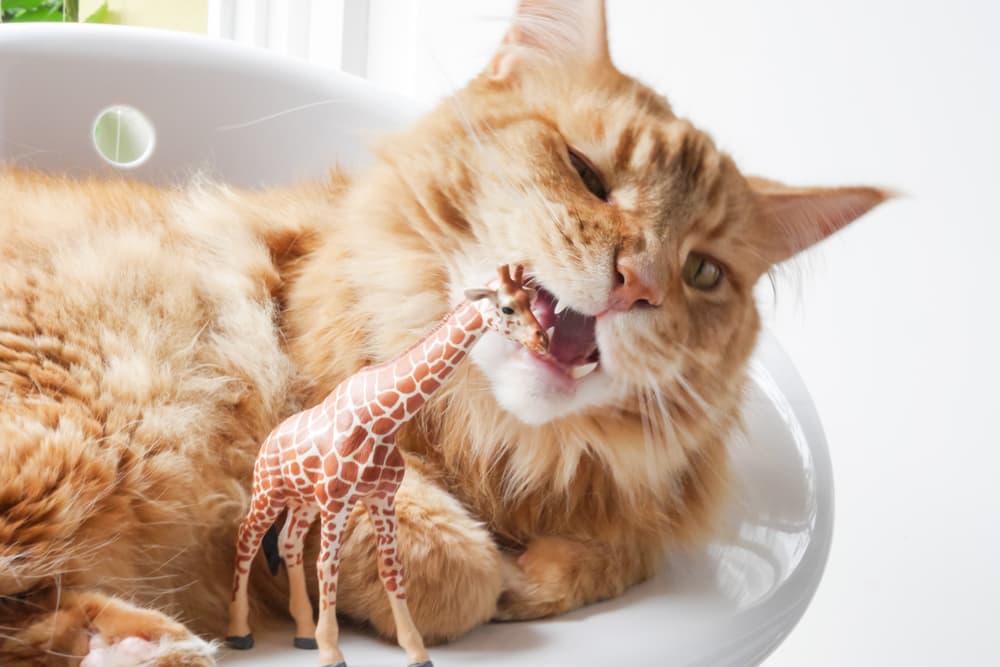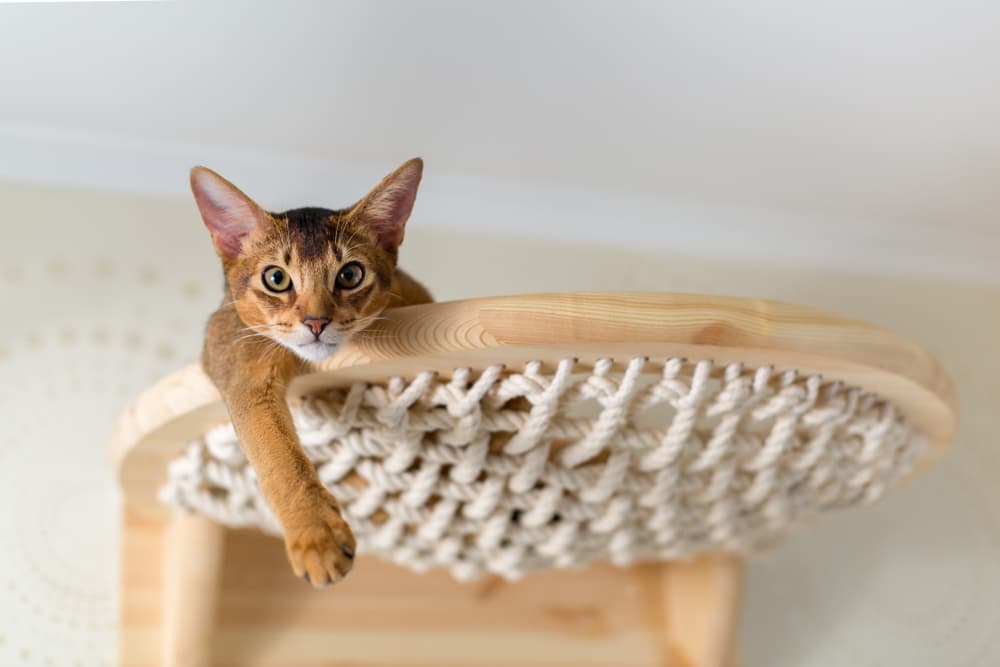Pica in Cats

Overview
- Pica in cats refers to the ingestion of non-food items.
- Cats with pica may chew on or eat wood, fabrics, blankets, or other objects.
- The biggest concern with pica is a gastrointestinal obstruction.
- Pica is difficult to diagnose in cats, because some chewing and sucking behavior is normal.
- Treatment usually focuses on environmental modification.
Pica refers to the ingestion of non-food items. While many cats ingest a non-food item at some point during their life, pica disorder in cats refers to felines who do this on a repeated, regular basis.
What Is Pica in Cats?
Cats with pica may eat or chew on a variety of items. Plants, string, and paper are common targets for many cats with this condition. Cats may also exhibit a form of pica known as wool-sucking, in which they suck on blankets, clothing, or other fabrics.
Pica is a poorly understood condition. Many cats demonstrate some degree of pica as part of their normal behaviors, which can make it challenging to determine whether an individual cat’s pica is normal or a cause for concern. Additionally, there has been little research on this aspect of feline behavior, resulting in limited information and awareness.
However, if you see your cat eating non-food items more than usual or if you feel like your cat’s behavior is cause for concern, it’s important to see a veterinarian. Pica increases the likelihood of your cat ingesting an object, which could result in intestinal obstruction.
Symptoms of Pica in Cats

Symptoms of pica in cats vary and it can be challenging to distinguish between normal playful behavior and destructive behavior.
True pica is associated with an abnormal frequency or an abnormal fixation on the ingestion of non-food items.
The following signs may be seen in cats with pica:
- Ingestion of items such as paper, toys, etc.
- Chewing on houseplants
- Vomiting of non-food items
- Suckling on wool or other fabrics
- Chewing of holes in fabrics
What Causes Pica in Cats?
There are numerous theories about what causes cats to develop pica. Unfortunately, the lack of research on this subject means that we do not yet know which causes are the most common. Wool-sucking and wool-chewing appear to be more common in Siamese and Burmese cats, but the reason for this association is unknown.
Potential medical causes of pica include:
- Nutrient deficiencies
- Gastrointestinal disease
- Neurologic (nervous system) disease
- Exposure to certain toxins
In most cats with pica, however, no underlying medical cause can be found.
Psychological factors also play a role in pica and may increase a cat’s risk. These factors include:
- Boredom
- Lack of mental stimulation
- Anxiety or compulsive disorder
- Social conflicts
- Redirected hunting behavior
- Early weaning
- Fasting
- Craving for fiber
Diagnosing Your Cat With Pica

There is no test that can be used to diagnose pica. Diagnosis is based on your observations at home, so it is important to take note of which items your cat is chewing or eating and how frequently this behavior occurs.
If your cat is showing signs of pica, consult your veterinarian. It may be helpful to bring detailed notes about your pet’s routines and behavior. Some helpful things to note and questions to ask yourself include:
- Feeding routine and food brand/type: Does your cat eat meals at the same time every day or do they free feed on food throughout the day?
- Household composition: Who makes up your household (i.e., human family members, other pets)? What is the environment inside and outside of the house (i.e., kids, loud, quiet neighborhood, cats outside, etc.)?
- Daily routine: Do you interact with your cat? Do they try to play or hunt? Do they sleep all day but they are up all night?
- Abnormal eating habits: Do you see your cat eat things or do you find chewed up items around your house when you come home from work?
- Your cat’s temperament: Is your cat friendly and wants to be pet, or do they try to attack when you get close?
- Gastrointestinal symptoms: Has your cat experienced vomiting, diarrhea, or gagging? If so, how frequently?
- Triggers: Have you noticed any triggers for your cat (i.e., hiding when guests come over, loud noises)?
When you bring your cat to the clinic for an appointment, your veterinarian will perform a physical exam to look for signs of illness and conduct bloodwork to rule out internal disease.
Your veterinarian will also make sure that your cat is on a well-balanced diet to prevent nutritional deficiencies. A diet change may be recommended.
Finally, your veterinarian may recommend further diagnostics to rule out gastrointestinal disease or other potential underlying conditions.
Pica Treatment for Cats
The treatment of pica primarily focuses on environmental modification. First, limit your cat’s access to those items that they are chewing on. Next, provide appropriate outlets for chewing. Small dog chew toys and cat grass can be offered to allow your cat to chew on items with a low risk of causing intestinal obstruction.
Ensure that your cat has ample outlets for play and hunting instincts, by using feeders that are designed to encourage natural foraging behaviors. Add regular, scheduled play sessions into your cat’s daily routine. Additionally, you may want to consider creating a safe, outdoor enclosure for your cat to spend some time in.
If there are particular stresses in your home, these stressors should be addressed. For example, if your cat is fighting with a housemate, you may need to devise a way to keep the cats separated or minimize interactions. If your cat is stressed by the presence of outdoor cats at your doors or windows, consider motion-activated sprinklers to discourage outdoor cats from collecting around your home. Talk to your veterinarian about any possible stressors that may be affecting your cat, in order to manage your cat’s anxiety level and minimize stress in the home.
In order to prevent foreign body obstruction, you may need to use deterrents to keep your cat from chewing on or ingesting certain objects. Bitter sprays are designed to have a foul taste, which may deter your cat from eating specific objects.
In severe cases, medication may be necessary. Your veterinarian may prescribe antidepressants to help reduce your cat’s anxiety level and manage pica.
Common Medications for Pica
While medication is not commonly used in the treatment of pica, some cats do benefit from antidepressants and anti-anxiety medications. Clomipramine and fluoxetine are two of the most commonly-used drugs for this condition, although they do not successfully address pica in all cats.
General Cost to Treat Pica in Cats
Many cases of pica do not require treatment. If your cat requires medications or has to undergo surgery for a gastrointestinal foreign body, however, there may be associated costs.
These costs may include:
- Diagnostics to rule out underlying medical conditions = $200-$500
- Medications to treat pica = $10-$30 per month
- Surgery to remove gastrointestinal foreign body = $1,000-$2,000
Treatment costs for cats with pica will vary based on your location and the veterinary treatment that is required.
How to Prevent Pica in Cats

The best prevention for pica in cats is to minimize stress. Ensure that your cat has outlets for normal play and hunting behaviors.
If you live in a multi-cat home, ensure that each cat has their own area, so that cats can have quiet time away from the other cats. Place an adequate number of food and water stations and an adequate number of litter boxes in your home. You should have one more litter box than the number of cats in your home.
Cats are natural hunters, so they need outlets to engage in hunting behaviors. The typical lazy life of an indoor cat does not give them an opportunity to exercise these instincts.
Instead of feeding your cat from a bowl, consider feeding all or part of your cat’s meal from a feeder that simulates natural hunting behaviors. These feeders are designed to be shaken or rolled by your cat, dispensing small amounts of food with manipulation. This is far more stimulating for cats than eating out of a bowl and allows them the opportunity to exercise normal hunting behaviors.
Related Conditions
- Gastrointestinal obstruction









